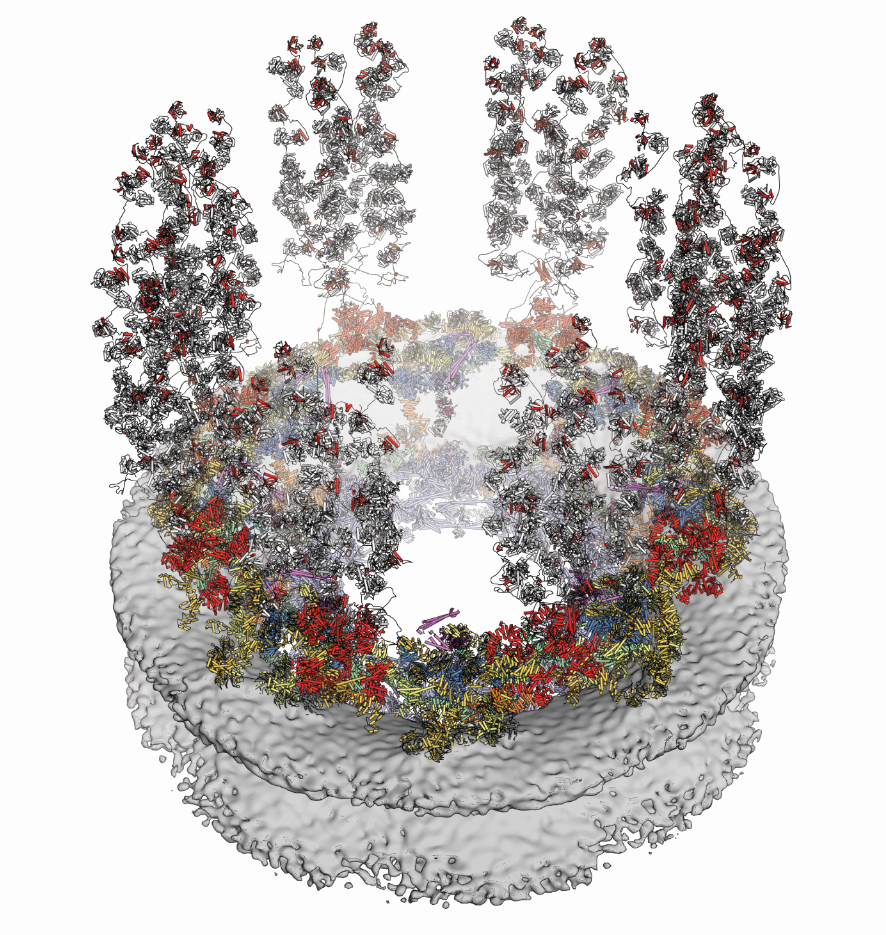Nearly 100 trillion cells make up the human body, which is what keeps people healthy and alive. The mechanisms of life are maintained by the billions of pieces that each cell has on its own.
 A molecular model of the outside (cytoplasmic) face of the nuclear pore complex. Image Credit: Reprinted with permission from C. J. Bley et al., Science (2022), Hoelz Laboratory/Caltech.
A molecular model of the outside (cytoplasmic) face of the nuclear pore complex. Image Credit: Reprinted with permission from C. J. Bley et al., Science (2022), Hoelz Laboratory/Caltech.
Nuclear pores, one of the most important parts of a cell, function like the doors and windows in a house by allowing significant substances, such as RNA and proteins, to enter and exit the nucleus of a cell. The cells and the rest of the body would stop working if nuclear pores were not present. Scientists have not previously been able to determine the precise composition and operation of nuclear pores.
Enter a group of scientists from the California Institute of Technology (Caltech), directed by professor of chemistry and biochemistry André Hoelz, who is also a faculty scholar at the Howard Hughes Medical Institute (HHMI).
By figuring out the architectures of its numerous parts and fitting them together, researchers finally succeeded in mapping the atomic structure of the nuclear pore complex (NPC) after nearly two decades of perseverance.
Understanding how the NPC functions within cells advance the knowledge of how cells function and may help develop new treatments for several malignancies, autoimmune and neurological disorders, as well as some heart issues.
Since the NPC is not a straightforward puzzle-like those that are waiting in pieces in a box, unraveling it required some time. It has more than 1,000 distinct proteins, and it might take years for researchers to map just one of them before they can start putting them together. The overall process resembles a massive three-dimensional jigsaw puzzle, but one built of pieces that are so small that neither the best light microscope nor the human eye can see them.
The Stanford Synchrotron Radiation Lightsource (SSRL) at the Department of Energy’s (DOE) SLAC National Accelerator Laboratory, the Advanced Photon Source at the DOE’s Argonne National Laboratory, and the National Synchrotron Light Source II at the DOE’s Brookhaven National Laboratory were used by the Caltech team to achieve this milestone.
They have used X-rays to illuminate the atomic structure and general shape of crystallized NPC protein samples in several experiments throughout the years.
This month, they presented their findings in two papers published in Science. The architecture of the face on the outside of the nucleus was described in the first study, and the second paper described the “glue” proteins that hold the NPC’s numerous components together.
X-ray crystallography provided atomic details of the individual protein components. As technologies have been improving, including at SLAC’s SSRL, researchers have been able to see the nuclear pore complex in clearer ways, so that they could fit the different proteins together to complete this complex puzzle.”
Aina Cohen, Senior Scientist, SLAC National Accelerator Laboratory
The study would not have been possible without SSRL’s enhanced equipment throughout the years, such as its microfocus capabilities and a pixel array detector (PAD), installed in 2009, according to Hoelz. The detector produced far better X-ray diffraction data than was previously achievable, assisting the Caltech scientists in mapping the protein structures of the NPC.
SSRL was home to one of the nation’s earliest PADs. It was demonstrated in 2015 that, with perseverance and diligence, the scientists could ultimately provide a comprehensive picture of the entire NPC by analyzing the crystal structure of a sizable six-protein chunk and establishing its arrangement in the nuclear pore.
“SSRL was the facility where most of the initial structural work occurred due to the ample access we had through Caltech’s Molecular Observatory, an X-ray crystallography facility with access to SSRL’s Beam Line 12-2,” Hoelz said.
Hoelz added, “This regular access allowed for the systematic improvement of various aspects of the X-ray diffraction experiments, which allowed us to solve even the most challenging nucleoporin structure determination problems. We had multiple structures that we worked on for over a decade before we solved them.”
According to Christopher Bley, a senior postdoctoral scholar research associate in chemistry at Caltech and a co-first author of the papers, the solution to the human NPC puzzle will now make it possible to conduct many significant investigations.
We have this composite structure now, and it enables and informs future experiments on NPC function, or even diseases. There are a lot of mutations in the NPC that are associated with terrible diseases, and knowing where they are in the structure and how they come together can help design the next set of experiments to try and answer the questions of what these mutations are doing.”
Christopher Bley, Study Co-First Author and Senior Postdoctoral Scholar Research Associate, Chemistry, California Institute of Technology
After identifying the human NPC structure, researchers can now concentrate on figuring out the molecular underpinnings of numerous enigmatic NPC functions, including how mRNA is extracted, the root causes of the numerous diseases affiliated with NPCs, and how numerous viruses, such as SARS-CoV-2 and monkeypox virus, aim NPC function to create new treatments, according to Hoelz.
Source:
Journal references:
- Bley, C. J., et al. (2022) Architecture of the cytoplasmic face of the nuclear pore. Science. doi.org/10.1126/science.abm9129.
- Petrovic, S., et al. (2022) Architecture of the linker-scaffold in the nuclear pore. Science. doi.org/10.1126/science.abm9798.